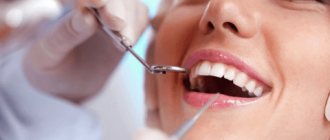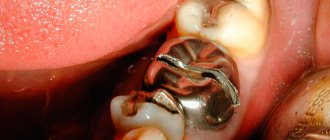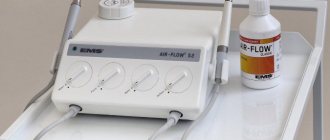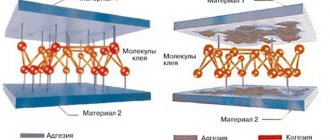Date of publication: 09/28/2018
Tooth filing has been used in dentistry since the 19th century. At that time, the procedure helped treat caries by mechanically removing damaged tissue. Today the technique is used to eliminate other problems, mainly aesthetic ones.
For example, teeth can be filed if one or more units stand out from the general row due to their increased length. Filing can also help with small chips on the edges of the tooth.
In what cases is tooth filing used?
There are different opinions about the advisability of the procedure. It is mainly carried out in the following cases:
- When the upper incisors or canines stand out too much. This not only disrupts aesthetics, but can also interfere with proper bite. In this state of affairs, the teeth can be shortened a little so that they fit better into the dentition.
- If there are small chips on the edges of the teeth. A slight grinding of the enamel will help smooth out the edge.
- If there are sharp corners. Sometimes, due to anatomical features, the front teeth may have protruding parts. They may not look aesthetically pleasing or even damage the cheek.
- For orthodontic bite correction. Sometimes teeth are filed down on the sides to make it easier to move them into the correct position. This is important when installing braces if your teeth are very crowded.
- Filing down the front of the teeth is used when installing veneers. The teeth are also ground down before crowns are installed.
The advisability of filing is determined individually only at the appointment of a specialist.
How is pathology determined?
Only a specialist can detect a violation during tooth wear. Of course, the general picture among the population is taken as the norm, but the doctor also takes into account individual factors:
- general condition of the enamel;
- presence or absence of exposed dentin;
- work of the temporomandibular joint;
- condition of the mucous membranes of the tongue and cheeks;
- degree of severity of nasolabial folds;
- sensitivity of the masticatory muscles.
It is interesting that in addition to all the individual characteristics, the doctor is interested in the sound with which the jaws close. A sharp, clear and short sound indicates that there are no problems. A long-lasting sound accompanied by a squeak indicates deficiencies in the functioning of the TMJ or problems with the nervous system.
You can understand that teeth are subject to increased abrasion by the first sign - increased sensitivity. It is sharper when the upper hard layer of enamel is significantly abraded.
Expert opinion
Roman Borisovich Alekperov
orthopedic dentist
Experience: 24 years
If there are indications for filing teeth, it is important to entrust this procedure to an experienced dentist who will correct the aesthetic defect and not cause harm to the teeth. Self-filing is impossible and extremely dangerous - you can seriously damage the tooth, and in the future you will have to resort to microprosthetics or crown prosthetics. There is also a high risk of injury to the mucous membrane and infection.
Modern and classic classification of abrasion
In modern Russian practice, the most widespread and popular is the Bushan classification of abrasion, which distinguishes:
✔
physiological abrasion (only enamel is affected);
✔
transitional (enamel + dentin suffers);
✔
pathological abrasion (dentin is damaged).
The benefit of the classification is that, in addition to the degree of pathology, it considers the surfaces (vertical, horizontal) that have undergone changes, the prevalence of the disease and the tooth sensitivity accompanying the process.
As for the types of pathological abrasion, the classical classification was developed by A. G. Moldovanov and L. M. Demner. According to their data, the rate of abrasion is 0.402 mm per year.
- The first degree of abrasion
is achieved by the age of 25-30 and is characterized by smoothing of the cusps and cutting edges of the teeth. - The second degree of abrasion
is observed in patients aged 44-50 years and is expressed in the abrasion of the enamel. - The third degree of abrasion
is noted if by the 50th anniversary the enamel limit has been reached and 10 pairs of chewing teeth have been preserved.
How is filing done?
The technology varies depending on the purpose for which the procedure is performed. The process includes a number of steps:
- - Diagnostics. The doctor determines which teeth will be filed and for what purpose. To do this, a visual inspection is carried out, the cause is studied, and the method of performing the procedure is determined.
- — The area in which manipulation is necessary is determined. For this, carbon paper, wax plates, and special aerosols can be used. This helps to highlight or color an area that, for example, prevents the jaws from closing properly. In difficult cases, a plaster model of the jaw can be made.
- If the procedure requires significant removal of hard tissue, anesthesia is performed.
- Sawing is done using a diamond bur. On chewing teeth, a small layer of enamel on the protruding tubercles can be filed away. If we are talking about incisors, the movements are multidirectional and depend on the situation.
- After the procedure, the surface that was manipulated is polished. Also, remineralizing substances can be applied to the surface of the teeth, as well as compositions to strengthen the surface and reduce sensitivity.
When filing teeth, the thickness of the enamel in the treated areas changes. This may cause increased sensitivity. Usually this is a temporary phenomenon and in the first days it is necessary to refrain from eating hot and cold foods so as not to provoke discomfort and pain. If the problem does not go away over time, you should consult a doctor.
Physiology is to blame for everything
To begin with, let's say that all the causes of tooth wear can be divided into two large classes - physiological and pathological.
The first reason appears immediately after the final eruption of baby teeth - and this is a natural process. In children, the incisors, cusps on the canines and molars gradually wear away, and by the age of 6 years, the depth of wear down to the dentin can be observed. In the future, until the age of 14, when the teeth are finally replaced by permanent ones, abrasion of the dentinal layer of the first teeth is sometimes noted. Severe abrasion is diagnosed when the entire upper part of the tooth disappears or the cavity becomes visible.
In general, due to physiological characteristics, teeth adapt to stress during the process of wear. Without dangerous overloads, the work of the entire dental system is adjusted; contacts between teeth change the angle from point to plane, so that the closure of the jaws is more physiological.
If the changes affect only the enamel, there is nothing to worry about. But if dentin begins to participate in the process of abrasion, this is a reason to consult a doctor.
Online consultation with a doctor
If you are interested in questions about teeth filing, you have been prescribed this procedure, but have doubts about its necessity, or are simply concerned about the condition of your teeth, then it is best to undergo an examination and get advice from a dentist. Under no circumstances should you do the filing yourself. A specialist will assess your dental health, listen to complaints and give professional recommendations. Without a competent opinion, you can complicate the situation, which will lead to illness or already have hidden illnesses. Treatment will be more expensive and, in some cases, longer. At the consultation, the vector of your next actions will be set and doubts will be dispelled.
At home
Fear of doctors and thoughts about the pain of professional manipulations often lead to patients trying to cope with the existing problem on their own. Teeth filing is also no exception.
Dentists share their experience that people often come to appointments whose enamel has been severely damaged by attempts to cut off part of it with various improvised tools in the desire to improve the aesthetic appearance of the jaw row with prominent front teeth or the presence of chips.
In addition to the problem of high sensitivity, these patients experience cracks in the hard tissue, as well as dentin damage, which develops as a result of bacteria entering the dentinal tubules through open pores.
The consequence of such independent actions can be the development of caries, pulpitis and numerous complications that can lead to partial or complete tooth destruction.
Dentists categorically prohibit performing teeth filing procedures at home. Only a specialist can determine the need for an operation to remove a section of enamel and carry it out efficiently, without the risk of complications.
Why does tooth wear occur?
What determines the level of tooth wear?
Wearing of teeth throughout life is a natural process that occurs to one degree or another in every person. The level of abrasion of hard dental tissues depends on various factors - the general state of their health, genetic predisposition to various diseases, the quality of food and water quality, sufficient intake of essential minerals, and also work in certain hazardous industries, for example, in the chemical industry, can speed up the process erasing the enamel.
How to straighten teeth without braces
Patients are often reluctant to get braces due to the long treatment period and the visual appeal of iron clasps. Bite correction using aligners has become a very popular procedure.
Aligners are trays made of transparent and elastic material that are applied to the entire dentition. The patient can take them off and put them on independently. The principle of their influence is imperceptible, gradual pressure on the teeth. This points them in the right direction. The material does not injure the gums, mucous membranes, enamel, and does not cause allergies.
At a consultation appointment at the Propricus clinic, the doctor will tell you in detail about this treatment. During the entire treatment period, the patient is given several sets of mouth guards. Aligners are prescribed if crowding or large gaps are diagnosed, if the jaw moves forward.
Before correcting a crooked tooth with mouth guards, you also need to sanitize your mouth. The aligners themselves can be cleaned with toothpaste and a toothbrush. There are no food restrictions. The only thing is that you need to remove the aligners before eating and then rinse your mouth.
Disadvantages of installing veneers without grinding
- ✔
If the tooth is not prepared before fixing the ceramic plate, then its surface is necessarily treated with a special acid, which irreversibly changes the color of the enamel to such an extent that it will not be possible to do without veneers in the future.
✔
Too thin lumineers, which do not require grinding of the teeth, are not able to effectively hide significant defects in the shape of the teeth.
✔
Thin veneers without grinding make teeth visually thicker, which negatively affects their aesthetics.
✔
Grinding allows you to create a correct and smooth transition of the veneer into the tooth tissue. Installing veneers without grinding the teeth can cause plaque accumulation, gum inflammation and the formation of caries in the cervical area.
Causes of pathological abrasion
There are several main reasons for the development of abrasion pathology, and in the first place among them are bad human habits. For example, the habit of gnawing seeds, holding small objects in the mouth (pins, cloves, pipe mouthpiece), love for foods with high acidity may well become catalysts for the process.
Often the cause of increased abrasion is diseases: bruxism, diseases of the gastrointestinal tract, nervous, cardiovascular, endocrine systems, from the side of the TMJ - malocclusion. The cause may also be improper dental treatment - an incorrectly manufactured orthopedic design can provoke severe abrasion of the antagonist tooth.
Sometimes the cause of pathology may be the chosen profession. Some employees of the metallurgical, cement, granite industries, and representatives of the mining workshop suffer from increased abrasion.
Crown as a way out
Pathological tooth wear can be eliminated with the help of crowns. They can be installed both on the front teeth and on the chewing teeth and restore the aesthetics and functionality of the oral cavity. Crowns can be made from various materials, each of which has its own advantages and disadvantages:
| Material | pros | Minuses |
| Metal ceramics | Durability, high aesthetic qualities, not the highest price | Depulpation of the tooth and grinding of a large amount of hard tissue are required. |
| Metal-free ceramics | The best aesthetics that are not lost over time, high strength, durability. | High price. |
| Metal | High strength, durability, low cost. | Lack of aesthetic qualities. |
When choosing a certain material, the patient must understand that he will need to replace a large number of crowns (perhaps even all). Therefore, it is worth giving preference to those materials that have good aesthetic qualities and a long service life.
After all the nuances of prosthetics have been agreed upon, we proceed directly to the procedure itself. At the first stage, the oral cavity is sanitized and teeth are prepared for crowns. Next, the doctor takes impressions of the jaws, based on which the dental technician makes a prosthesis. These operations may take some time, so the patient may be offered temporary plastic crowns. They will protect prepared teeth from the aggressive environment of the oral cavity and help adapt to new teeth. After the final version of the prosthesis is ready, it is tried on again and fixed with permanent cement.
How to straighten teeth for an adult
If you think that an overbite is just unsightly, then you are mistaken. The anomaly is dangerous due to the uneven distribution of the chewing load. When chewing food, not only the dentition, but also the joints collapse.
To stay healthy and look good, you should not delay orthodontic treatment. Our clinic’s orthodontists install correction systems for patients of any age. The doctor, together with the patient, selects the correction method.
Basic methods of orthodontic treatment in adults:
Fixed structures
The most common correction method is to correct the bite using a braces system. They help correct pathologies of varying degrees. Even the heaviest ones. Fixed structures successfully cope with problems of the oral cavity, both physiological and aesthetic.
Our clinic uses different types of structures. For example, lingual or sapphire vestibular braces can be installed on the upper jaw. Visually they are invisible.
Combined treatment
If there are severe skeletal disorders and bite deformities, then the professional knowledge and skills of an orthodontist and surgeon are required. Doctors create a comprehensive treatment plan, which includes jaw surgery and correction with braces.
Correction with aligners, veneers, lumineers
Veneers are used to correct the anterior row. The downside of the structures is the need to grind down your own healthy teeth. Lumineers fit tighter and look more natural. There is no longer any need to endure discomfort from braces. Aligners are used to correct simple dental anomalies. They are smooth, transparent, and cannot be seen. This gentle correction method can completely replace braces.
The result of treatment does not depend on age. An experienced orthodontist will make your smile perfect, no matter your age. At the Propricus clinic they know everything about how to correct crooked teeth without pain. During the consultation, the doctor will select possible treatment options and tell you about the duration of the correction. Next, the decision is yours.
Sign up for free 3D modeling of your future smile!
Make an appointment
*By making an appointment you consent to the processing of your data
Crooked teeth are not a death sentence
With the onset of a certain age, people often come to the understanding that it is time to change something. Including in appearance. Modern plastic surgery can correct any mistakes of nature, erase traces of years and fatigue from the face. It's sad when all your efforts are ruined by an ugly smile.
Along with cosmetic manipulations, bite correction in adults becomes an important step on the path to transformation and gaining self-confidence. A good orthodontist can help straighten teeth for patients of any age.
Veneers and teeth grinding are the main problems
Veneers are thin plates of ceramic or reflective composite materials used to correct the shape or color of teeth. Microprostheses have many advantages - high aesthetics, durability and reliability. But at the same time, the overlays have a significant drawback, which often becomes a reason for patients to refuse the procedure. We are talking about such an important stage as preparing the tooth before installing veneers.
Interesting fact!
Veneers were first invented in America in the 30s of the twentieth century. At first they were made to order for Hollywood stars, so that they would shine not only with their talents, but also with their perfect, dazzling smiles. However, at that time they were glued to the teeth for only a few days with a special adhesive mixture. Compared to modern orthopedic designs, these were primitive and crude onlays for quick correction of teeth during filming.










